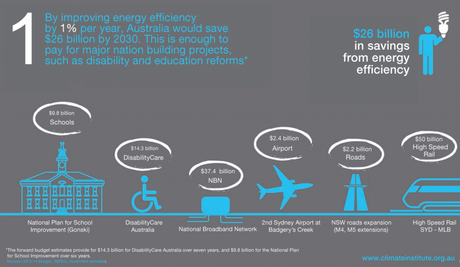According to a study commissioned by The Climate Institute (Australia) in partnership with GE, Australia’s poor investment in energy efficiency is costing the more than a billion dollars of economic growth per year. The study has found that should Australia continue to lag behind other countries in terms of energy efficiency, it will lose $26 billion in revenue by 2030.

(Credit: The Climate Institute, Australia) Click to enlarge Infographic.
“If Australia improved its energy efficiency by just an extra one per cent each year it would generate an additional $8 billion in GDP by 2020 and $26 billion by 2030,” said John Connor, CEO The Climate Institute. “This is an important contribution to improving Australia’s productivity, as well as cutting our energy bills and carbon pollution.
”This new research, the first to quantify the impact that energy efficiency can have on economic output, found that on average a 1 per cent improvement in energy efficiency boosted GDP per person by 0.1 percentage points. It was carried out by Vivid Economics and is based on analysis of over 30 years of data from 28 countries.
There are opportunities for Australia to trim its energy use right across the economy in simple ways. For example, major industrial sectors like manufacturing, resources extraction and processing, construction, and freight and air transport could cut their energy use by 11 per cent, saving companies some $3 billion each year, according to recent research by ClimateWorks Australia. Energy saving tactics range from sectors, but can include upgrading equipment, retrofitting buildings and refining operational processes.
GE Australia & New Zealand Director of ecomagination, Ben Waters, said there was enormous potential to achieve productivity gains and eliminate costs from some of Australia’s major industries, such as mining, and manufacturing.
“This new research reaffirms that improvements in energy efficiency and economic growth are not mutually exclusive,” said Waters. “By making even small investments in our energy productivity, we have the opportunity to reach new levels of efficiency, drive economic growth and improve utilization of our scarce energy, mineral, agricultural and water resources while reducing carbon emissions.”
Agencies like the International Energy Agency (IEA) and others have found that Australia has a very poor record on investing in energy efficiency and trails competitors in rates of improvement. Australia’s annual energy efficiency improvement of about 0.5 per cent is below the IEA average of 1 per cent per year for countries assessed, and well below that of many comparable economies such as the United States (0.9 per cent) and Canada (1.4 per cent).
For Australia to realize the economic benefits of energy efficiency, The Climate Institute supports expanding on the current patchwork of energy efficiency measures to boost 2010 energy productivity levels by 30 per cent by 2020, by:
- Replacing inconsistent state-based energy saving schemes with a nationally consistent and robust Energy Saving Initiative covering the whole country;
- Introducing ambitious emissions/efficiency standards for vehicles similar to those of the United States and Europe;
- Increasing performance standards for equipment and products;
- Ensuring that energy pricing more accurately reflects the true costs of energy use (eg. time-of-use and critical peak electricity pricing; removal of fossil fuel subsidies; pricing pollution generated from energy);
- Maintaining the carbon price mechanism, which encourages reduced energy use.
“Our research puts a figure on just how much we are missing out on,” said Connor. “The reality is that our current policies are inadequate to address the barriers preventing smarter energy use. To get to the next level, we need policies like a national energy saving initiative, ambitious performance standards for vehicles and equipment, and bipartisan support for a robust long-term signal for low carbon investment. Other countries—like Japan, China, South Korea, the United States and the UK—are taking these and similar steps. We cannot afford to keep wasting billions of dollars and the carbon pollution reduction opportunities that greater efficiency brings.”
Connor added: “We need to get beyond the idea that energy efficiency means changing light bulbs. In fact, just about every product and process can be streamlined to reduce energy waste. “Businesses are starting to recognize this, but there’s a lot more they can do.”

